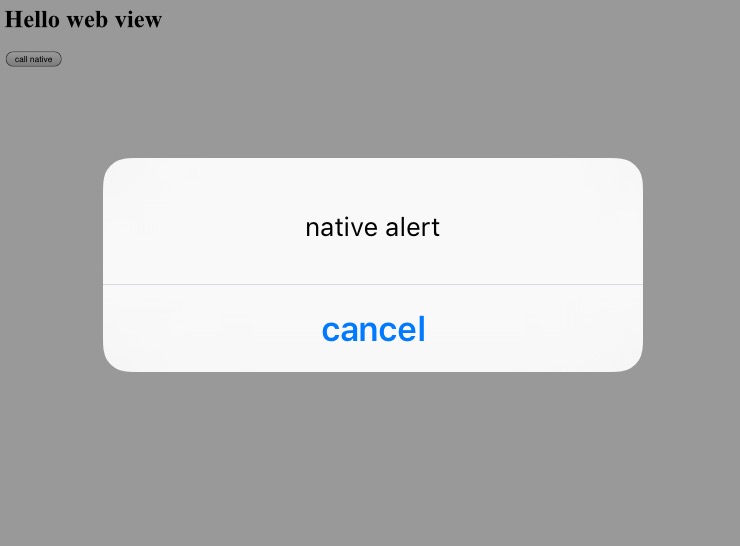react native之WebView中注入js接口(jsBr

前言
在react native之前,大都采用hybird方案,目前WebView已经是app中不可或缺的一部分,采用react native之后依然需要支撑。react native核心库中就带有WebView的封装,但只是最基础支撑,要扩展WebView的功能,手段之一就是注入js,俗称jsBridge。
react native需要iOS7以上系统支撑,因此注入js有两种方案:
- 通过Request Url截获解析。这是在iOS7之前采用的方式。
- 通过系统提供的javascriptCore通信方式。
这里我们讨论第二种方案,如果你对jsBridge不太熟悉,可以看这篇H5与native之间的通信。如果对javascriptCore不熟悉,可以看这个javascriptCore详解。
既然已经有成熟的方案,为什么还要写这篇文章?
还是那句话,最好不要修改react native原有代码,对以后的版本控制以及维护都不好,下面就来看看如何不修改react native实现需求,先放出项目地址。
JS注入实现
要给WebView注入js,需要WebView资源加载完毕时,获取WebView的JSContext。也就是在- (void)webViewDidFinishLoad:(UIWebView *)webView回调方法中通过[webView valueForKeyPath:@"documentView.webView.mainFrame.javaScriptContext"]获取上下文,然后就可以为所欲为了。
那么关键点还是在:如何不侵入react native内部源码。
这时候category和swizzling隆重登场。首先使用swizzling替换原有webViewDidFinishLoad方法:
+(void)load {
RCTSwapInstanceMethods([RCTWebView class], @selector(initWithFrame:), @selector(newInitWithFrame:));
RCTSwapInstanceMethods([RCTWebView class], @selector(webViewDidFinishLoad:), @selector(newWebViewDidFinishLoad:));
}
然后在新方法中,除了执行原有逻辑之外,再执行js注入:
- (void)newWebViewDidFinishLoad:(UIWebView *)webView {
[self injectWebView: webView];
[self newWebViewDidFinishLoad: webView];
}
-(void) injectWebView: (UIWebView *) webView {
JSContext *context = [webView valueForKeyPath:@"documentView.webView.mainFrame.javaScriptContext"];
if (context == nil) {
return;
}
//自定义注入对象
__weak typeof(self) weakSelf = self;
context[@"alert"] = ^(NSString *message) {
dispatch_async(dispatch_get_main_queue(), ^{
UIAlertView *alert = [[UIAlertView alloc] initWithTitle:@"" message: message delegate:weakSelf cancelButtonTitle:@"cancel" otherButtonTitles:nil, nil];
[alert show];
});
};
}
这里定义了个简单的函数alert,用于调用native方法。下面验证下注入是否有效,在js侧定义WebView,并自动调用alert方法,为简单起见WebView加载本地html:
const HTML = `<html>
<body>
<h1>Hello web view</h1>
<input type="button" value="call native" onclick='buttonAction()'/>
<script>
function buttonAction() {
alert('native button alert');
};
alert('native alert');
</script>
</body>
</html>`;
<WebView
ref={'webView'}
automaticallyAdjustContentInsets={false}
// style={styles.webView}
source={{html: HTML}}
// source={{url:'https://www.baidu.com'}}
javaScriptEnabled={true}
domStorageEnabled={true}
decelerationRate="normal"
onNavigationStateChange={this.onNavigationStateChange}
onShouldStartLoadWithRequest={this.onShouldStartLoadWithRequest}
// startInLoadingState={true}
scalesPageToFit={true}/>
看下效果:

单独提一下,iOS中的WebView每次finishLoad时JSContext都会发生变化,所以要在每次load结束时重新注入js。还有一种情况是,在资源加载过程中需要调用native接口,那么就要在WebView创建时同时获取JSContext注入js:
- (instancetype)newInitWithFrame:(CGRect)frame {
RCTWebView *slf = [self newInitWithFrame: frame];
UIWebView *webView = [slf valueForKey:@"_webView"];
[self injectWebView: webView];
return slf;
}
RCTWebView自身提供了一个属性injectedJavaScript,用于资源加载完毕时自动执行的一段js脚本。比如你需要把jsBridge的js侧代码库注入到目标页,可以使用这个属性。
react native的JSContext获取、注入
react native项目自身使用的JSContext与WebView的JSContext不是一回事儿,也就是说你在react native的JSContext中注入接口,WebView是无法访问到的,反之亦然。如果你需要将js接口在react中和WebView中能同时使用,必须两边都要注入。
react native关于JSContext的封装在RCTJSCExecutor中,它实现了一个通知RCTJavaScriptContextCreatedNotification,当JSContext创建完毕,还未加载main.jsbundle时会发送通知,JSContext作为通知的参数传递过来。
于是,一切就简单了,我们注册这个通知获取JSContext:
+(void)load {
[[NSNotificationCenter defaultCenter] addObserver:self selector:@selector(recieveNotification:) name:RCTJavaScriptContextCreatedNotification object:nil];
}
+(void) recieveNotification: (NSNotification *) notification {
JSContext *context = notification.object;
__weak typeof(self) weakSelf = self;
//这里由js线程调用,所以UI操作需要指定主线程
context[@"alert"] = ^(NSString *message) {
dispatch_async(dispatch_get_main_queue(), ^{
UIAlertView *alert = [[UIAlertView alloc] initWithTitle:@"" message:@"native alert" delegate:weakSelf cancelButtonTitle:@"cancel" otherButtonTitles:nil, nil];
[alert show];
});
};
}
功能实现了,不过这里要提醒一句,react native实现了一套js与native模块化通信的机制,虽然我们依然可以给react通过JSContext注入的方式,但不建议这么使用,通过react native提供的模块导出方法才是正道。
关于react native模块的知识,可以参考react native之模块
如果需要理解react native通信机制原理,可以参考react native之OC与js之间交互
这些都偏源码,可能有的读者不喜欢看,后面会单独出一篇react native模块开发的章节。


